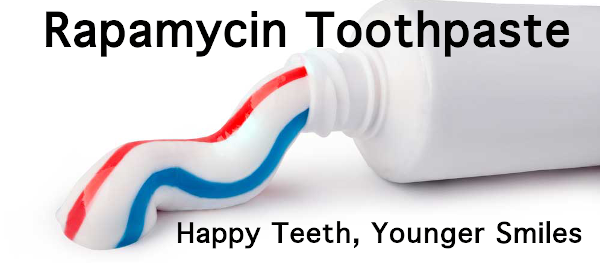
Great news for the University of Washington Research Team being led by the usual suspects, Jonathan An, Matt Kaeberlein et al.
$300,000 in funding from VitaDao for this new research project which looks at the potential for rapamycin and other small molecules (I suspect other mTOR inhibitors like everolimus, etc.) to treat and reverse periodontal disease. And if all goes well, as I expect it will, we’ll all be using Rapamycin toothpaste soon…
Come to think of it, we may need an entirely new, larger bathroom cabinet for the rapamycin skin cream to slow skin aging, rapamycin shampoo for hair follicle aging, hair loss/color restoration, and now rapamycin toothpaste.
The idea for this current study came from last year’s successful research in this area, as covered in this post: New Study: Rapamycin Rejuvenates Oral Health in Aging Mice.
Project PI : Dr Jonathan An
Simple Summary
Periodontal disease (periodontitis) is a chronic oral disease impacting over 70% of older adults, where inflammation of the tissues supporting the teeth results in loss of connective tissue attachment, bone, and ultimately the tooth. The greatest underlying risk factor for periodontitis is age, and its association with other age-related diseases, such as heart disease, diabetes, and Alzheimer disease, highlights the importance of incorporating this oral disease in geroscience studies. Jonathan An’s lab proposes to test a series of compounds targeting inflammation in a mouse model of age-related periodontitis, with the goal of finding a geroscience-based treatment for this neglected disease that has a severe impact on human healthspan.
Problem
Efforts to slow the progression of periodontitis in older adults have been attempted through various therapies, including scaling and root planing (“deep cleanings”) or antibacterial adjuncts to reduce pathogens in the pocket, but these treatment modalities are invasive, need to be repeated often, and rely on access to such modalities, which may be limited for many older adults. Furthermore, current therapies are limited to treating the symptoms and fail to address the underlying cellular and molecular causes of periodontal disease, which we hypothesize are a direct consequence of biological aging.
Opportunity
A component in most age-related disease and decline is a low-grade, chronic inflammation without overt infection known as “inflammaging”. Among the various organ systems that undergo inflammaging, periodontal disease involves most, if not all, sources and outcomes of inflammaging. Thus, evaluating pathways that target “inflammaging” may provide a unique, Geroscience-based treatment modality to reverse periodontal disease. This novel approach to treat periodontal disease is expected to establish the first medical, non-surgical treatment for an age-related oral disease. Moreover, this approach to treat periodontal loss is expected to have a positive impact on age-related cognitive decline.
Jonathan An’s Lab proposes to use small molecule inhibitors of the PI3K/NFkB/mTOR pathway to treat periodontal disease, and will test 5 candidates administered orally in the chow in an 8-week study, using rapamycin as a positive control. The drugs have well established pharmacokinetics and pharmacology since they have been investigated for other indications.
If this first study demonstrates that any of the small molecules is effective in reversing periodontal disease when administered systemically, a second sub-study will be carried out to test the effectiveness of their local delivery by brushing the interventions across the gum line, comparing them with locally delivered rapamycin.
The proposal is mainly based on a recent eLife paper (Rapamycin rejuvenates oral health in aging mice | eLife) by the research group, where they find positive effects of 8-week treatment with oral rapamycin in age-related periodontal bone loss in mice. The proposed interventions have never been before tested in the context of aging and periodontal disease. Johnathan An’s Lab envision improvement of the periodontal disease phenotype after 8-week treatment with the candidate compounds maybe a result of (1) an improvement of systemic “inflammaging” to impact periodontal disease that will be tested with the first study, or (2) a direct improvement of periodontal disease, which will be tested with the second study. Either result could be the base for novel IP regarding formulation and/or delivery methods to improve aging, inflammation, and periodontal disease. Jonathan An’s collaborators also have preliminary data showing that a few of the tested interventions have beneficial effects on neurodegeneration and cognitive decline. Therefore, besides periodontal bone loss, the study will address effects on cognitive function and lifespan.
Results from the proposed study will provide critical pre-clinical IP data to support a future company targeting periodontal disease through geroscience, which the investigator(s) intend to spin out with support from VitaDAO.
IP Roadmap
If any of the locally administered treatments reverses periodontal disease, Jonathan An’s team envision the following path towards IP:
-
Localized Delivery of Compound X to Oral Cavity
-
To treat (indications):
- Age-related periodontal disease in older adults
- Peri-implantitis (periodontal disease of implants) in older adults
-
Method 1: Compound X Toothpaste
- Prescription (from the dental office or medical office)
- Over the counter (in low doses)
-
Method 2: Direct Delivery of Compound X to periodontal pockets with periodontal disease
- IP surrounding both formulation and delivery mode
- Completed in dental offices (medical offices)
-
Example : Local delivery of antimicrobial compounds, Arestin Ò
-
Method 3: Compound X trays
If Jonathan An’s Lab observes an effect in lifespan and healthspan, additional test of feasibility and safety in other mammalian models (i.e., non-human primates) will begin for application in clinic to target aging.
Full Project Details here: VDP-18 [Funding] Jonathan An - Towards reversing periodontal disease using Geroscience